Lower Silesian Voivodeship
Lower Silesian Voivodeship, or Lower Silesia Province[3] (Polish: województwo dolnośląskie [vɔjɛˈvut͡stfɔ dɔlnɔˈɕlɔ̃skʲɛ]) in southwestern Poland, is one of the 16 voivodeships (provinces) into which Poland is divided.
Lower Silesian Voivodeship Województwo dolnośląskie | |
|---|---|
 Flag  Coat of arms | |
.png) Location within Poland | |
 Division into counties | |
| Coordinates (Wrocław): 51°07′N 17°02′E | |
| Country | |
| Capital | Wrocław |
| Counties* | List
|
| Government | |
| • Voivode | Jarosław Obremski (PiS) |
| • Marshal | Cezary Przybylski (BS) |
| Area | |
| • Total | 19,946.74 km2 (7,701.48 sq mi) |
| Population (2019-06-30[1]) | |
| • Total | 2,899,986 |
| • Density | 150/km2 (380/sq mi) |
| • Urban | 1,986,877 |
| • Rural | 913,109 |
| ISO 3166 code | PL-02 |
| Vehicle registration | D |
| HDI (2017) | 0.875[2] very high · 3rd |
| Website | http://www.umwd.dolnyslask.pl/ |
| |
The history of the region dates back over a thousand years and Lower Silesia was once part of Medieval Poland, Bohemia, Austria, Prussia, Germany and modern Poland after 1945. At its foundation the territory was under the rule of the Piast dynasty and became a duchy. It was divided into small realms reigned by Piast princes after the testament of Bolesław III Wrymouth in 1138. During this time, cultural and ethnic Germanic influence prospered due to immigrants from the German-speaking areas of the Holy Roman Empire. Lower Silesia was also a leading Polish cultural center. The Book of Henryków, which contains the earliest known sentence written in the Polish language, as well as a document which contains the oldest printed text in Polish, were both created here. Złotoryja, Poland's first town, was granted municipal privileges according to German Magdeburg rights by Henry the Bearded. Over the next centuries, Lower Silesia has experienced epochal events such as the Protestant Reformation, the Silesian Wars, industrialisation and the two World Wars, suffering a nearly total loss of its German population and Polish new settlement after 1945.
Lower Silesia is one of the richest provinces in Poland as it has valuable natural resources such as copper, brown coal and rock materials, which are exploited by the biggest enterprises. Its well developed and varied industries attract both domestic and foreign investors.[4]
Its capital and largest city is Wrocław, situated on the Oder River. It is one of Poland's largest and most dynamic cities with a rapidly growing international profile, and is regarded as one of the most important commercial, educational and tourist sites in the whole country. Burial sites of Polish monarchs and consorts are located in Wrocław and Trzebnica. Furthermore, the voivodeship is famous for its many castles and palaces and is one of Poland's most visited regions by tourists.
History and geography
The voivodeship was created on 1 January 1999 out of the former Wrocław, Legnica, Wałbrzych and Jelenia Góra Voivodeships, following the Polish local government reforms adopted in 1998. It covers an area of 19,946 square kilometres (7,701 sq mi), and as of 2019 has a total population of 2,899,986.
Although much of the region is relatively low-lying it also includes Sudeten Foreland and part of the Sudetes mountain range running along the Polish/Czech border. Popular ski resorts in Lower Silesian Voivodeship include Karpacz and Szklarska Poręba in the Karkonosze mountains. Other important tourist destinations in the voivodeship include the chief city, Wrocław, as well as the towns of Jelenia Góra and Legnica. The town of Boleslawiec is famed for its pottery.
The voivodeship has the largest number of spa towns in Poland: Cieplice Śląskie-Zdrój, Długopole-Zdrój, Duszniki-Zdrój, Jedlina-Zdrój, Kudowa-Zdrój, Lądek-Zdrój, Polanica-Zdrój, Przerzeczyn-Zdrój, Szczawno-Zdrój, and Świeradów-Zdrój.
Lower Silesian Voivodeship is bordered by Lubusz Voivodeship to the north-west, Greater Poland Voivodeship to the north-east, Opole Voivodeship to the south-east, the Czech Republic (Hradec Králové Region, Liberec Region, Olomouc Region and Pardubice Region) to the south, and Germany (Saxony) to the west.
Transport
The Wrocław–Copernicus Airport serves as an international and domestic airport.
The main railway station is Wrocław Główny.
The A4 motorway, A8 motorway and A18 motorway run through the Voivodeship.
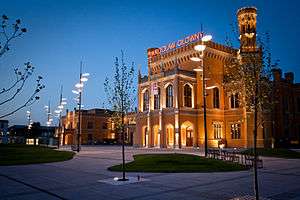 Wrocław Główny railway station is a major railway hub in the region
Wrocław Główny railway station is a major railway hub in the region- Jelenia Góra railway station
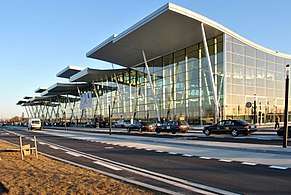

.jpg) Overpass in Lewin Kłodzki
Overpass in Lewin Kłodzki
Tourism
Lower Silesian Voivodeship is one of the most visited voivodeships in Poland. It is famous for a large number of castles (99) and palaces (hundreds), inter alia: Książ Castle, Czocha Castle, Chojnik Castle, Grodziec Castle, Gorzanów Castle, Kliczków Castle. There is also a lot in the Jelenia Góra valley.
The voivodship's most widely visited city is Wrocław with many sights and attractions, inter alia open all year round Aquapark, Wrocław SPA Center and famous Wrocław's dwarfs.
The annual international Chopin Festival is held in the Fryderyk Chopin Theatre in Duszniki-Zdrój, established at the site of the first concert played by the Polish virtuoso pianist outside of the Russian Partition of Poland. Other major attraction of the town is the Museum of Papermaking, established in a 17th-century paper mill.
The Festival of Good Beer is held every year, on the second weekend of June.
Śnieżka is one of the first European peaks visited by tourists, it is also the highest peak of the Lower Silesian Voivodeship and the whole of the Sudetes.
Other highlights include: Kłodzko Fortress, Fort Srebrna Góra, Wambierzyce, Legnickie Pole, Henryków, Lubiąż Abbey, Krzeszów Abbey, Oleśnica Mała, Vang Stave Church, Churches of Peace, Sokołowsko, Cave Bear, Museum of Gold Mining and Metallurgy in Złoty Stok, Coal Mine in Nowa Ruda, Museum of Industry and Railway in Jaworzyna Śląska, Skull Chapel in Czermna, Mount Ślęża, Table Mountains, Owl Mountains, Karkonosze, The Main Trail Sudetes, Barycz Valley Landscape Park and connected with the history of World War II – complex tunnels Project Riese, a German Gross-Rosen concentration camp, German War Cemetery and Park Peace in the Nadolice Wielkie.
- Castles and palaces (examples)

_ID_593146.jpg) Piast Castle in Legnica
Piast Castle in Legnica2a.jpg)
.jpg)
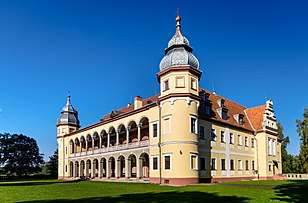 Krobielowice Palace
Krobielowice Palace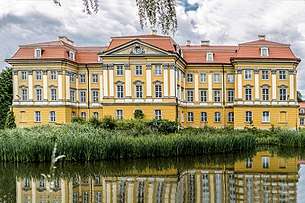 Radomierzyce Palace
Radomierzyce Palace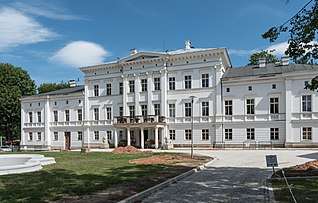 Jedlinka Palace in Jedlina-Zdrój
Jedlinka Palace in Jedlina-Zdrój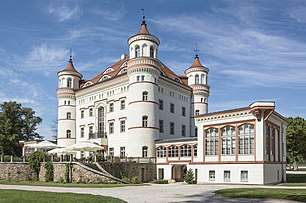 Wojanów Palace
Wojanów Palace
- Burial sites of Polish monarchs and consorts

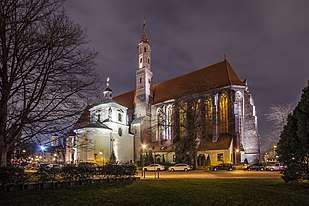
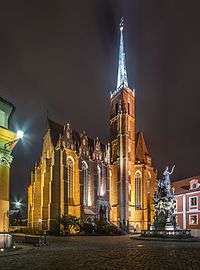
 Church of St. Clare and Hedwig church, Wrocław
Church of St. Clare and Hedwig church, Wrocław
Protected areas
.jpg)
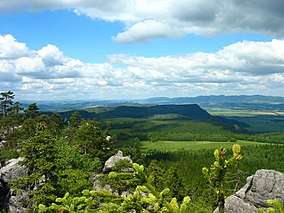

Protected areas in Lower Silesian Voivodeship:
- 2 National Parks
- Karkonosze National Park (part of a UNESCO trans-border biosphere reserve)
- Table Mountains National Park
- 12 Landscape Parks
- Barycz Valley Landscape Park (partly in Greater Poland Voivodeship)
- Bóbr Valley Landscape Park
- Bystrzyca Valley Landscape Park
- Chełmy Landscape Park
- Jezierzyca Valley Landscape Park
- Książ Landscape Park
- Owl Mountains Landscape Park
- Przemków Landscape Park
- Rudawy Landscape Park
- Ślęża Landscape Park
- Śnieżnik Landscape Park
- Sudety Wałbrzyskie Landscape Park
- 67 Nature reserves
- 20 protected landscape areas
- 3100 Natural monuments
- 114 Ecological usages
- 15 Teams nature and landscape
and many areas of Natura 2000 network.
Economy
Lower Silesia is one of the richest regions in Poland. The Gross domestic product (GDP) of the province was 41.1 billion € in 2018, accounting for 8.3% of the Polish economic output. GDP per capita adjusted for purchasing power was 23,400 € or 78% of the EU27 average in the same year. The GDP per employee was 85% of the EU average. Lower Silesia Voivodship is the province with the second highest GDP per capita in Poland.[5]
Since 2005, the voivodeship recorded the highest in the country economic growth rate (around 10% per annum).
GDP per capita in Lower Silesia Voivodeship: GDP in Poland:
| Lower Silesian Voivodeship | GDP per capita | Poland | GDP per capita |
|---|---|---|---|
| 2000 | $10 440 (+2.8%) | 2000 | $10 140 (+4.0%) |
| 2005 | $13 060 (+4.9%) | 2005 | $12 600 (+3.5%) |
| 2006 | $13 700 (+7.3%) | 2006 | $13 020 (+6.2%) |
| 2007 | $14 980 (+9.5%) | 2007 | $13 760 (+6.5%) |
| 2008 | $16 030 (+7.2%) | 2008 | $14 450 (+5.0%) |
| 2009 | $16 350 (+2.0%) | 2009 | $14 720 (+1.9%) |
The southwest part of the Voivodeship is considered part of the so-called Black Triangle, an area of heavily industrialization and environmental damage on the three-way border of Poland, Germany, and the Czech Republic.[6]
Cities and towns
The voivodeship contains 91 cities and towns. These are listed below in descending order of population (as of 2019):[1]
- Wrocław city county (641,607)
- Wałbrzych city county (111,896)
- Legnica city county (99,486)
- Jelenia Góra city county (79,200)
- Lubin (72,428)
- Głogów (67,317)
- Świdnica (57,041)
- Bolesławiec (38,852)
- Oleśnica (37,169)
- Dzierżoniów (33,239)
- Oława (33,029)
- Zgorzelec (30,374)
- Bielawa (29,971)
- Kłodzko (26,845)
- Jawor (22,890)
- Świebodzice (22,793)
- Polkowice (22,480)
- Nowa Ruda (22,067)
- Lubań (21,087)
- Kamienna Góra (19,010)
- Bogatynia (17,436)
- Strzegom (16,106)
- Jelcz-Laskowice (15,803)
- Złotoryja (15,564)
- Boguszów-Gorce (15,368)
- Ząbkowice Śląskie (15,004)
- Chojnów (13,355)
- Trzebnica (13,331)
- Brzeg Dolny (12,511)
- Strzelin (12,460)
- Wołów (12,373)
- Góra (11,797)
- Milicz (11,304)
- Kowary (10,869)
- Syców (10,397)
- Bystrzyca Kłodzka (10,134)
- Kudowa-Zdrój (9,892)
- Środa Śląska (9,516)
- Oborniki Śląskie (9,099)
- Lwówek Śląski (8,869)
- Ziębice (8,708)
- Siechnice (8,113)
- Chocianów (7,892)
- Pieszyce (7,123)
- Kąty Wrocławskie (6,994)
- Sobótka (6,981)
- Żarów (6,719)
- Twardogóra (6,692)
- Gryfów Śląski (6,636)
- Szklarska Poręba (6,557)
- Żmigród (6,435)
- Piława Górna (6,412)
- Głuszyca (6,361)
- Polanica-Zdrój (6,324)
- Piechowice (6,194)
- Przemków (6,107)
- Lubawka (6,028)
- Pieńsk (5,828)
- Stronie Śląskie (5,709)
- Szczawno-Zdrój (5,608)
- Ścinawa (5,582)
- Lądek-Zdrój (5,572)
- Szczytna (5,141)
- Jaworzyna Śląska (5,124)
- Bolków (4,990)
- Bierutów (4,867)
- Jedlina-Zdrój (4,828)
- Karpacz (4,593)
- Duszniki-Zdrój (4,584)
- Leśna (4,439)
- Olszyna (4,348)
- Nowogrodziec (4,243)
- Zawidów (4,180)
- Świeradów-Zdrój (4,147)
- Mieroszów (4,070)
- Mirsk (3,886)
- Wojcieszów (3,668)
- Prochowice (3,602)
- Niemcza (2,965)
- Węgliniec (2,846)
- Złoty Stok (2,758)
- Wąsosz (2,662)
- Międzylesie (2,575)
- Bardo (2,562)
- Radków (2,406)
- Międzybórz (2,341)
- Świerzawa (2,286)
- Prusice (2,243)
- Wiązów (2,241)
- Lubomierz (1,979)
- Wleń (1,759)
Administrative division
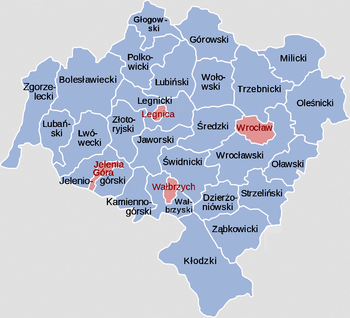
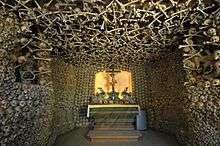
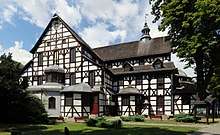
Lower Silesian Voivodeship is divided into 30 counties (powiats), four of which are city counties. These are further divided into 169 gminas.
Lower Silesia is divided into three districts administracyji province government, the capital of Wrocław (administrative region):[7]
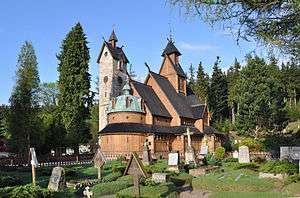
- 1 one district Wałbrzyski
- Powiats in the district
Świdnica, Kłodzko, Ząbkowice Śląskie, Dzierżoniów
- 2 second district Legnicki
- Powiats in the district
Glogów, Jawor, Lubin, Polkowice, Złotoryja
- 3 third district Jeleniogórski
- Powiats in the district
Boleslawiec, Kamienna Góra, Luban, Lwówek Śląski, Zgorzelec.
The counties are listed in the following table (ordering within categories is by decreasing population).
Governors
| Name | Period |
|---|---|
| Witold Krochmal | 4 January 1999 – 22 October 2001 |
| Ryszard Nawrat | 22 October 2001 – 21 March 2003 |
| Stanisław Łopatowski | 31 March 2003 – 21 December 2005 |
| Krzysztof Grzelczyk | 21 December 2005 – 29 November 2007 |
| Rafał Jurkowlaniec | 29 November 2007 – 1 December 2010 |
| Aleksander Skorupa | 28 December 2010 – 11 March 2014 |
| Tomasz Smolarz | 12 March 2014 – 8 December 2015 |
| Paweł Hreniak | 8 December 2015 – present |
References
- "Population. Size and structure and vital statistics in Poland by territorial divison in 2019. As of 30th June". stat.gov.pl. Statistics Poland. 15 October 2019. Retrieved 14 February 2020.
- "Sub-national HDI – Area Database – Global Data Lab". hdi.globaldatalab.org. Retrieved 13 September 2018.
- Arkadiusz Belczyk,Tłumaczenie polskich nazw geograficznych na język angielski Archived 3 March 2016 at the Wayback Machine [Translation of Polish Geographical Names into English], 2002–2006.
- "Past and Present Regions of Poland – Lower Silesia". Archived from the original on 20 July 2016. Retrieved 10 March 2017.
- "Regional GDP per capita ranged from 30% to 263% of the EU average in 2018". Eurostat.
- "Archived copy" (PDF). Archived from the original (PDF) on 13 April 2014. Retrieved 16 April 2014.CS1 maint: archived copy as title (link) page 9
- Internet, JSK. "Delegatury Urzędu – Dolnośląski Urząd Wojewódzki". Archived from the original on 31 May 2013. Retrieved 10 March 2017.
External links
| Wikivoyage has a travel guide for Dolnośląskie. |
- Województwo Dolnośląskie Official website
- Website of the government of Lower Silesia

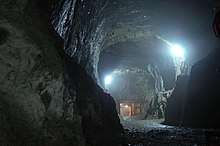
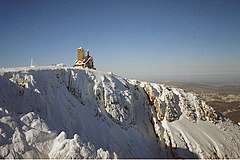
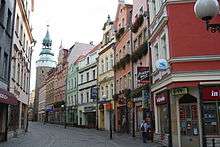
.jpg)
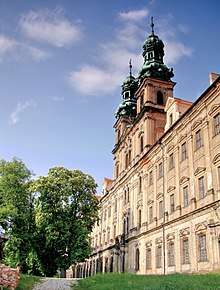
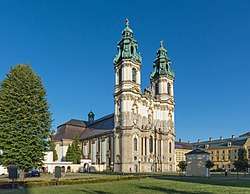
.jpg)

